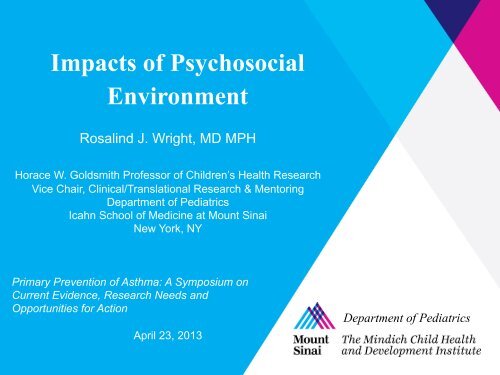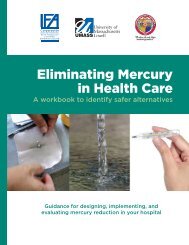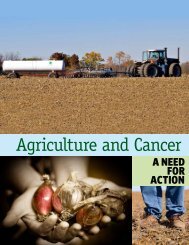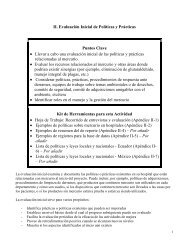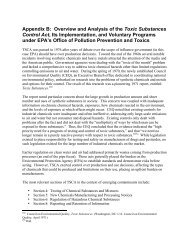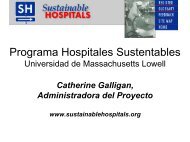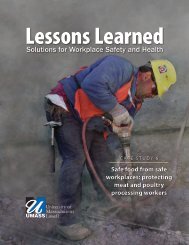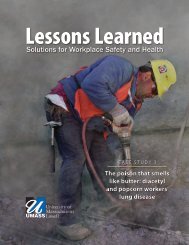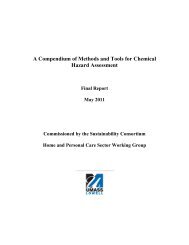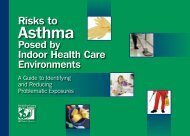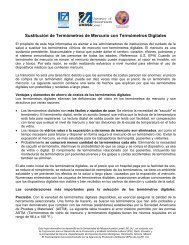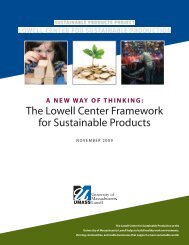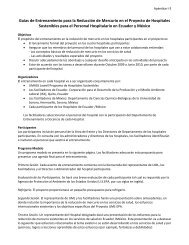Impacts of Psychosocial Environment
Impacts of Psychosocial Environment
Impacts of Psychosocial Environment
You also want an ePaper? Increase the reach of your titles
YUMPU automatically turns print PDFs into web optimized ePapers that Google loves.
<strong>Impacts</strong> <strong>of</strong> <strong>Psychosocial</strong><br />
<strong>Environment</strong><br />
Rosalind J. Wright, MD MPH<br />
Horace W. Goldsmith Pr<strong>of</strong>essor <strong>of</strong> Children’s Health Research<br />
Vice Chair, Clinical/Translational Research & Mentoring<br />
Department <strong>of</strong> Pediatrics<br />
Icahn School <strong>of</strong> Medicine at Mount Sinai<br />
New York, NY<br />
Primary Prevention <strong>of</strong> Asthma: A Symposium on<br />
Current Evidence, Research Needs and<br />
Opportunities for Action<br />
April 23, 2013<br />
Department <strong>of</strong> Pediatrics
OLD WINE IN NEW BOTTLES<br />
Mental suffering impairs physical<br />
well-being and adversely affects<br />
the respiratory organs<br />
Universally understood in the 12th<br />
century<br />
.. the success <strong>of</strong> relieving the<br />
patient depends largely on an<br />
intimate knowledge <strong>of</strong> the total<br />
patient.<br />
Treatise on Asthma<br />
Maimonides<br />
Rabenu Moshe Ben Maimon<br />
(1135 - 1204)
Figure 2. Meta-analysis about the effect <strong>of</strong> stress on atopic disorders.<br />
Chida Y et al. Psychosom Med 2008;70:102-116<br />
© 2008 American Psychosomatic Society
Wright et al., Thorax 1998; 53:1066-74<br />
Wright et al., JACI 2005; 5:23-9.
BIOLOGY OF STRESS<br />
▶<br />
The stress reaction is neither<br />
good nor bad in itself<br />
▶<br />
Depends on circumstances<br />
▶<br />
Stress is useful when it<br />
protects us in times <strong>of</strong> danger<br />
or helps us to adapt in times<br />
<strong>of</strong> change.<br />
OPTIMAL BALANCE = HEALTH
Overview Model<br />
External event/<br />
Stressor<br />
Benign<br />
appraisal<br />
Appraisal <strong>of</strong><br />
demands and<br />
coping capabilities<br />
Perceived<br />
stress<br />
Physical toxins<br />
Tobacco smoke<br />
Ambient AP<br />
Allergens<br />
Negative emotional<br />
responses<br />
Atopic Disease<br />
Airway responses<br />
Lung growth
Social & Physical Toxins Impact Fetal Programming<br />
Prescott & Clifton, Cur Opin All Clin Immunol 2009; 9:417-26
Measures <strong>of</strong> Stress & Stress Correlates<br />
▶<br />
▶<br />
▶<br />
Acute life events:<br />
– Recent life experiences (job loss, housing problems)<br />
– Remote life experiences (trauma)<br />
Chronic strains:<br />
– Persistent life difficulties (poverty)<br />
– Role strains (e.g., balancing work & home responsibilities)<br />
– Racism / Discrimination<br />
– Community-wide strain / Ecologic level strain<br />
• community violence<br />
• collective efficacy/disorder<br />
Stress Correlates:<br />
– Pregnancy Anxiety<br />
– Perceived Stress<br />
– Depression/Anxiety/PTSD
Individual-level Stress/Stress Correlates<br />
LITERATURE STUDY TYPE SUBJECTS EXPOSURE/<br />
OUTCOME<br />
RESULT [+/-; OR/<br />
RR/HR (95% CI)]<br />
Cookson et al., JACI<br />
2009<br />
Unselected Pregnancy<br />
Cohort (N=5,810)<br />
Child<br />
(7.5 yrs)<br />
Maternal anxiety (32 wks<br />
gestation and 1 st yr postpartum)<br />
MD Dx Asthma w/symptoms and/<br />
or meds in past 12 mos<br />
OR 1.64 (1.3, 2.2)<br />
Exposure response, p
Individual-level Stress/Stress Correlates<br />
LITERATURE STUDY TYPE (N) SUBJEC<br />
TS<br />
Wood RA et al.,<br />
JACI 2011<br />
Urban <strong>Environment</strong> and<br />
Childhood Asthma<br />
(URECA)<br />
Child (1 yr)<br />
EXPOSURE/<br />
OUTCOME<br />
Perceived Stress (late pregnancy)<br />
Depression (yr 1)<br />
RESULT<br />
[+/-; OR/<br />
RR/HR<br />
(95% CI)]<br />
See figure<br />
Selected Pregnancy Cohort<br />
(N=515)<br />
Repeated wheeze (> 2)<br />
Each model adjusted for site, child gender, season <strong>of</strong> birth
Individual-level Stress/Stress Correlates<br />
LITERATURE STUDY TYPE (N) SUBJEC<br />
TS<br />
Wright RJ et al.,<br />
AJRCCM 2002<br />
Home Allergen & Asthma<br />
Study (HAA)<br />
Selected Pregnancy Cohort<br />
(N=496)<br />
Child (14<br />
mos)<br />
EXPOSURE/<br />
OUTCOME<br />
Perceived Stress (repeated q 2<br />
mos from birth)<br />
Repeated wheeze (> 2)<br />
RESULT [+/-;<br />
OR/RR/HR<br />
(95% CI)]<br />
OR 2.1 (1.3, 3.4)<br />
Percent with > 2 episodes <strong>of</strong> wheeze<br />
Adjusted for maternal race, education, smoking, breastfeeding, child gender, season <strong>of</strong> birth, BW, LRIs, household allergens
Individual-level Stress/Stress Correlates<br />
LITERATURE STUDY TYPE (N) SUBJEC<br />
TS<br />
EXPOSURE/<br />
OUTCOME<br />
RESULT [+/-; OR/RR/<br />
HR (95% CI)]<br />
Chiu Y-HM et al.,<br />
AJRCCM 2011<br />
Asthma Coalition on<br />
Community, <strong>Environment</strong><br />
& Social Stress (ACCESS)<br />
Prospective<br />
Child<br />
(2 yrs)<br />
Maternal NLEs (mid-pregnancy<br />
and 12-18 mos postpartum)<br />
Repeated wheeze (> 2)<br />
Exposure Response<br />
OR 3.0 (1.7, 5.5) high-high vs.<br />
low-low NLEs<br />
Unselected Pregnancy<br />
Cohort (N=653)<br />
Pre- and Postnatal Maternal NLEs and Repeated Childhood Wheeze<br />
Adjusted for maternal atopy, race, education, smoking, child gender, season <strong>of</strong> birth, BW z-score,<br />
household cockroach allergen, traffic-related BC, ND index
Stress x <strong>Environment</strong> Interactions<br />
LITERATURE STUDY TYPE (N) SUBJEC<br />
TS<br />
EXPOSURE/<br />
OUTCOME<br />
RESULT [+/-; OR/RR/<br />
HR (95% CI)]<br />
Peters JL et al., Allergy<br />
2012<br />
Pregnancy Cohort<br />
(N=403)<br />
Child (birth)<br />
Prenatal maternal NLEs x<br />
Dust mite mother’s bedroom x<br />
Maternal Atopy<br />
P for 3-way interaction<br />
=0.005<br />
Cord Blood Total IgE<br />
Prenatal stress (NLEs) x DM allergen x maternal atopy<br />
2<br />
Predicted Log Cord Blood IgE Levels (IU/ml)<br />
1.5<br />
1<br />
0.5<br />
0<br />
-0.5<br />
-1<br />
-1.5<br />
-2<br />
-2.5<br />
0 2 4 6 8 10 12<br />
Number <strong>of</strong> Domains with Negative Life Events<br />
High Dust Mite Allergen<br />
(>=0.20 µg/g)<br />
Low Dust Mite Allergen<br />
(=0.20 µg/g))<br />
Linear (Low Dust Mite<br />
Allergen (
Stress x <strong>Environment</strong> Interactions<br />
LITERATURE STUDY TYPE (N) SUBJEC<br />
TS<br />
EXPOSURE/<br />
OUTCOME<br />
RESULT [+/-; OR/RR/<br />
HR (95% CI)]<br />
Shankardass K et al.,<br />
PNAS 2009<br />
Children’s Health Study<br />
Prospective school-aged<br />
cohort<br />
N=2,497<br />
Child (5-9<br />
yrs followed<br />
for 3 years)<br />
Prenatal maternal NLEs<br />
Dust mite mother’s bedroom<br />
Maternal Atopy<br />
Cord Blood Total IgE<br />
Effect <strong>of</strong> TRAP on incident asthma across parental stress quartiles<br />
See figure<br />
Adjusted for child age, gender, race/ethnicity and community random effects
Place-Based Stress – Community Violence<br />
LITERATURE STUDY TYPE (N) SUBJEC<br />
TS<br />
Gupta RS et al., Ann<br />
Allergy Asthma<br />
Immunol 2010<br />
Cagney KA et al., J<br />
Gen Intern Med 2004<br />
Sternthal MJ et al.,<br />
ERJ 2010<br />
Cross-sectional survey<br />
N=45,371<br />
Cross-sectional<br />
N=3,268 individual<br />
N=338 neighborhoods<br />
Project on Human<br />
Development in Chicago<br />
Neighborhoods (PHDCN)<br />
Prospective<br />
Unselected Accelerated<br />
Prospective Cohort<br />
N=2,071 individuals<br />
N=338 neighborhoods<br />
Child (K-8<br />
grade in<br />
Chicago<br />
public/<br />
Catholic<br />
Schools)<br />
Adults (43 +<br />
16 yrs)<br />
Child (0-9<br />
yrs two<br />
waves <strong>of</strong><br />
follow up)<br />
EXPOSURE/<br />
OUTCOME<br />
Crime data (Chicago Police Dept)<br />
TC High v. Low<br />
VC High v. Low<br />
Race Adjusted VC High v. Low<br />
MD Dx Asthma<br />
Collective Efficacy<br />
Neighborhood Disorder<br />
MD Dx asthma/emphysema/chronic<br />
bronchitis or other breathing problems<br />
Community Violence<br />
Low<br />
Medium<br />
High<br />
Asthma MD Dx or Rx Meds<br />
RESULT [+/-;<br />
OR/RR/HR (95%<br />
CI)]<br />
OR 1.5 (1.3, 1.8)<br />
OR 1.8 (1.5, 2.2)<br />
OR 1.3 (1.04, 1.6)<br />
18% residual<br />
neighborhood variance<br />
for respiratory outcome<br />
---<br />
OR 1.6 (1.2, 2.2)<br />
OR 1.6 (1.1, 2.2)
Place-Based Stress – Community Violence<br />
LITERATURE STUDY TYPE (N) SUBJEC<br />
TS<br />
EXPOSURE/<br />
OUTCOME<br />
RESULT [+/-; OR/RR/<br />
HR (95% CI)]<br />
Chiu Y-HM et al.,<br />
submitted manuscript<br />
ACCESS Study<br />
Prospective unselected<br />
pregnancy cohort<br />
Child (2 yrs)<br />
Prenatal ECV<br />
Prenatal TRAP<br />
• Black Carbon<br />
• PM2.5<br />
See figure<br />
N=708<br />
Repeated wheeze (> 2)<br />
ECV, Black Carbon, and PM2.,5<br />
16
Prenatal ECV, BC and Early Asthma Phenotypes<br />
* Adjusted for child’s gender, season <strong>of</strong> birth, maternal race, education level, atopy, and prenatal cockroach allergen.
Interactions <strong>of</strong> ECV & TRAP
Cortisol in Health and Disease<br />
Decreased<br />
Increased
Maternal prenatal cortisol trajectory<br />
associated with early asthma risk in children<br />
Wright RJ et al. Am J Resp Crit Care Med (in press)
Immune Function in Health and Disease<br />
Decreased<br />
Increased
Higher prenatal maternal stress alters child’s immune<br />
response at birth<br />
Low à High Stress Low à High Stress Low à High Stress<br />
Wright RJ et al., AJRCCM 2010; 182:25-33.
Causal Inference from Observational Data on<br />
<strong>Psychosocial</strong> Stress and Early Asthma Phenotypes<br />
ü<br />
ü<br />
ü<br />
ü<br />
ü<br />
Biological plausibility<br />
Temporal sequence – prospective prenatal & early childhood cohorts a<br />
particular strength<br />
Exposure-response relationship<br />
Robust to adjustment for a number <strong>of</strong> important confounders and pathway<br />
variables<br />
Robust to sensitivity analyses – alternate approaches to characterizing<br />
stress; alternate analytical approaches<br />
– Known to be associated with early asthma phenotypes
Summary<br />
▶<br />
▶<br />
▶<br />
▶<br />
▶<br />
Socially toxic environments are NOT simply a marker <strong>of</strong> a more toxic<br />
physical environment<br />
Social contexts and consequent stress may be as detrimental to children’s<br />
health as chemical toxins<br />
– Social pollutants/toxins<br />
Psychological stress disrupts biological systems overlapping with those<br />
altered by physical pollutants/toxins<br />
– Independent effects<br />
– Interactive (joint) effects<br />
Individual- and place-based psychosocial stress may impact host resistance<br />
such that physical toxins (e.g., indoor allergens, traffic-related air pollution)<br />
may have adverse effects, even at relatively lower doses<br />
Epidemiological studies and interventions need to address physical toxins<br />
and social stress jointly to impact public health most effectively<br />
Mount Sinai / Presentation Slide / December 5, 2012 24
Looking ahead…..
``<br />
``<br />
Social and Economic Policies <br />
Ins7tu7ons <br />
Neighborhoods/Communi7es <br />
Living Condi7ons (housing, workplace, <br />
socioeconomic status) <br />
Other Social Rela7onships <br />
Caregiver-‐child Rela7onships <br />
Gene7c/Epigene7c Factors <br />
Child at birth <br />
Prenatal <br />
Development <br />
Wright RJ Immunol Allergy Clinics NA 2011


